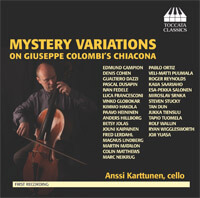

Anssi Karttunen
Colombi’s chiacona was written in the 17th century, and sounds a lot like the music of his Baroque contemporaries. It begins with a simple repetition of one note that falls into a melody which becomes the bass line for the rest of the piece. It then develops into a section with spritely, galloping scales, and goes through a few more transformations with chords and even faster moving scalar patterns before returning home to the original melody. The chiacona, a traditional baroque dance form, is defined by this structure. In this way, chiaconas are traditionally musings on a single idea, much like a theme and variations. By including the work of so many composers on the album, each deriving inspiration from this one piece as their theme, Karttunen’s birthday team created a sort of meta chiacona – or at least a large scale form of theme and variations, where the Colombi theme is a theme and variations in and of itself.
The real interest in the Mystery Variations on Giuseppe Colombi’s Chiacona is in seeing how the different composers chose to treat this assignment. Some of them took the more literal route and quoted whole phrases directly from the original, or utilized baroque sounding harmonies or imitative styles. But most of them latched on to one distinctive element, such as the dotted rhythmic pattern, note repetition, chordal motion, or melodic shape, and played with transforming and developing that idea as a motif. The order that the short variations are presented in the album (which Karttunen decided on after seeing them all completed) tends to favor contrast – slow is followed by fast, loud is followed by soft, etc. The order also tends not to put two composers next to each other who are concerned with the same element of the original.
Some of the more successful variations come from the composers who were creative in their use of the original chiacona’s thematic material. Perhaps my favorite piece on the album comes from Tan Dun, who incorporated vocalization of the word “chaccone” (the French form of the Italian word “chiacona”) in a rhythmic chant over strummed chords. The other composer who utilized vocalization to great success is Vinko Globokar, whose contribution “Idée Fixe” creates a counterpoint between the instrument and the performer’s voice. Globokar treats the cello mostly as a percussive instrument through hitting, scratching, and plucking sounds, with Karttunen’s voice humming fragments of the original Colombi melody and providing the only lyrical melodic material. At first, it seems as if the humming is stuck in Karttunen’s head, but it quickly grows in volume and becomes the primary voice as the cello fades into accompaniment. Other notable contributions on the album come from Roger Reynolds, Steven Stucky, Esa-Pekka Salonen, Edmund Campion, Pablo Ortiz, Luca Francesconi, Gualtiero Dazzi, and Kaija Saariaho.

Annsi Karttunen, Mystery Variations on Giuseppe Colombi’s Chiacona (Toccata Classics, 2013) | Buy on Amazon.com | Buy on Amazon.ca | Buy on Amazon.co.uk
